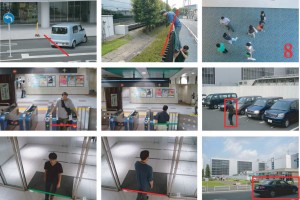Addressing the natural human limits of monitoring multiple video feeds
Video analytics software ‘watches’ the feed from a camera or the playback from a recorder, and flags instances when certain patterns have changed in a way preset by the operator.

Trying to increase vigilance while contending with manpower shortages, some communities are increasing their use of fixed-video surveillance cameras. This technology can be a force multiplier, but it’s neither a panacea nor a substitute for plain old human eyes. Some citizens regard them as a step toward “Big Brother.”
If you live in or visit any urbanized community, you’ve probably become accustomed to being on camera. Small businesses like convenience stores and dry cleaners have security cameras aimed at their doors and points of sale, and transit hubs are monitored from most every perspective. Large cities like New York and Chicago have neighborhood cameras mounted on buildings and utility poles to deter crime and generate leads when crimes do occur in their vicinity.
When Conventional Wisdom is Wron
Conventional wisdom holds that each of those cameras feeds to a central monitoring center, where watchful sentinels note anything suspicious and alert the cops when they see it. This almost never happens.
Humans just can’t focus on an array of video monitors for very long before they stop seeing anything at all. It’s bad enough when a watcher has to keep track of a single display — this is why the TSA rotates X-ray scanner operators every 15-20 minutes at airports. What does work, although still needful of human assistance, is a kind of filter built into some video analytics systems.
Video analytics software “watches” the feed from a camera or the playback from a recorder, and flags instances when certain patterns have changed in a way preset by the operator. In a security passageway where traffic is supposed to be moving in single direction, movement the other way will trip the flag if the software has been set that way. Another alert occurs when an object not normally in view of the camera appears and remains in one spot, like a bomb-carrying parcel might.
It doesn’t take much imagination to envision an innocent situation that would meet the conditions described here. Someone might drop their keys while walking down the passageway and turn around to retrieve them, or a maintenance worker can leave a mop bucket on the floor during a break. This is where the human intervention comes in. If the system notes an exception and sounds the alarm, the result isn’t a SWAT callout. The operator on duty brings up the screen where the exception occurs and determines whether it’s something innocuous or meritorious of having an officer respond to investigate.
Consumer- and Commercial-Grade Solution
There are two major flavors of analytic software — that which resides on the camera and another type on the analysis end. The camera-based software looks for whatever patterns it’s told to look for, then yells for attention when it finds it. There are basic applications used for consumer-grade simple monitoring and alarm systems. You can aim a webcam at your entryway or back yard, and tell the analytic application to sound the alarm if there are any changes in the picture, like the door opening or someone walking through the yard. The software decides what the basic scene looks like, then sends the alert when there’s a substantial change. You can generally set the sensitivity level, so a cat or dog walking through the frame won’t trigger the alarm. Because the camera doesn’t have a lot of memory or processing capability onboard, there won’t be a lot of options or fine tuning available.
Monitor-side software can perform the more advanced functions discussed previously, but it requires a lot more processing power. If there is no one constantly monitoring the output and able to dispatch someone to investigate, there’s not much point in having it run constantly. More commonly, this kind of application runs when a recording is later analyzed when an event has already taken place and there’s an investigation to determine who or what was responsible.
How does this affect you, the law enforcer? If your agency is contemplating deployment of a video surveillance system, or even a single camera, how that video link is monitored is as important as where the camera is placed. Assigning a desk clerk, dispatcher, or some other fixed-post employee to watch it is not likely to produce good results. But add in some analytical software, and you may be able to leverage the surveillance capability to be a useful tool.
http://www.policeone.com/police-technology/software/video-analysis/articles/3377046-Addressing-the-natural-human-limits-of-monitoring-multiple-video-feeds/






